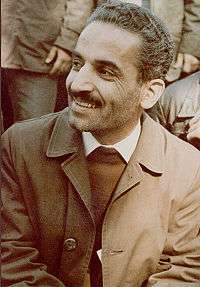Iranian presidential election, July 1981
| | |||||||||||||||||||||||
| |||||||||||||||||||||||
| |||||||||||||||||||||||
| |||||||||||||||||||||||
The Iranian presidential election of July 1981 took place on 24 July 1981 after the previous Iranian president, Abolhassan Banisadr, was impeached by the Majlis on 21 June and then sacked by the Supreme Leader, Ayatollah Khomeini, on 22 June. This led to the election of Mohammad Ali Rajai, the previous prime minister, winning 13,001,761 votes out of the 14,573,803 votes cast, which was 89% of the votes. The vote turnout was 65.29%.[1]
Rajai was killed a few weeks later on 30 August 1981, together with his prime minister, Mohammad Javad Bahonar.
Results
| Party | Candidate | Votes | Percentage | |||
|---|---|---|---|---|---|---|
| Islamic Republican Party candidate | Mohammad-Ali Rajai | 12,960,619 | 91.0% | |||
| Islamic Republican Party ran independent |
Abbas Sheibani | 626,301 | 4.4% | |||
| Islamic Republican Party ran independent |
Ali Akbar Parvaresh | 401,035 | 2.8% | |||
| Islamic Republican Party ran independent |
Habibollah Asgar-Owladi | 252,349 | 1.8% | |||
| Blank or invalid votes | 402,248 | |||||
| Totals | 14,642,552 | 100.00% | ||||
| Source: Nohlen, Dieter; Grotz, Florian; Hartmann, Christof (2001). "Iran". Elections in Asia: A Data Handbook. I. Oxford University Press. p. 75. ISBN 0-19-924958-X. | ||||||
References
- ↑ Buchta, Wilfried (2000). Who rules Iran? (PDF). The Washington Institute and The Konrad Adenauer Stiftung. p. 36.
This article is issued from Wikipedia - version of the 11/15/2016. The text is available under the Creative Commons Attribution/Share Alike but additional terms may apply for the media files.

